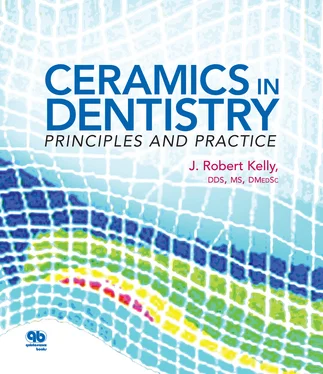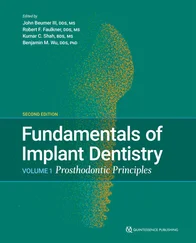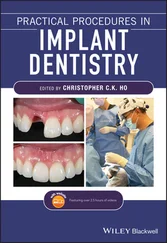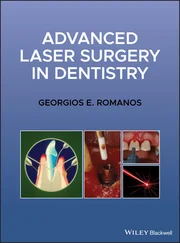For particle-filled glasses in dental ceramics, the filler particles are added to increase the strength and fracture toughness of the ceramic. The first successful strengthened-substructure ceramic was made in 1965 of feldspathic glass filled with particles of aluminum oxide (approximately 55 mass%). 4Today, commonly used fillers include aluminum oxide, leucite, and lithium disilicate. These particles can decrease the natural flaw size of the ceramic and make crack initiation and propagation more difficult. They also generally increase the opacity of the ceramic as well by increasing light scattering. Light scattering is caused by differences in the index of refraction between the matrix glass and the filler particles: The closer the indices of refraction, the more translucent the product (in a very strong relationship, the square of the difference). Leucite’s refractive index is very close to that of feldspathic glass, and hence leucite can be used in relatively high concentrations of 35 mass% to 50 mass%. This is also true of lithium disilicate, which is found at approximately 70 mass% in pressed and CAD/CAM ceramics that are esthetically suitable for monolithic prostheses.
Glass-ceramics
Crystalline filler particles can be added mechanically to the glass, for example, by simply mixing together crystalline and glass powders prior to firing. In a more recent approach, the filler particles are grown inside the glass object (prosthesis or pellet for pressing into a mold) after the object has been formed. After forming, the glass object is given a special heat treatment, causing the precipitation and growth of crystallites within the glass. Because these fillers are derived chemically from atoms of the glass itself, it stands to reason that the composition of the remaining glass is altered as well during this process known as ceraming , which is covered in more detail in chapter 5. Such particle-filled composites are called glass-ceramics . The material Dicor (Dentsply), the first commercial glass-ceramic available for fixed prostheses, contained filler particles of a type of crystalline mica (at approximately 55 vol%). More recently, a glass-ceramic containing 70 vol% crystalline lithium disilicate filler has been commercialized for dental use (Empress 2, now e.maxPress and e.maxCAD). New glass-ceramics based on lithium silicate are becoming available from Vita (Vita Suprinity) and Glidewell (Obsidian). Consumer products made from glass-ceramics include cooking and tableware (Pyroceram, including Corningware and Centura), stove cooktops and fireplaces (Ceran, Eurokera), telescope mirrors (Zerodur), and military applications including missile radomes. Link 6 shows a video of the production of Empress Esthetic at Ivoclar Vivadent, including base and creamed pellets as well as an animation of ceraming.
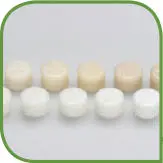
Empress Esthetic production.
Polycrystalline Ceramics
Polycrystalline ceramics have no glassy phases; all of the atoms are densely packed into regular arrays that are much more difficult to drive a crack through than the loose and irregular networks of atoms found in glasses. Hence, polycrystalline ceramics are generally much tougher and stronger than glassy ceramics. Because of their strength, polycrystalline ceramics are also more difficult to process into complex shapes (eg, a prosthesis) than are glassy ceramics. Well-fitting prostheses made from polycrystalline ceramics were not practical prior to the availability of CAM. In general, these computer-aided systems use a 3D data set representing either the prepared tooth or a wax model of the desired substructure. This 3D data set is used either to create an enlarged die upon which ceramic powder is packed (Procera, Nobel Biocare) or to machine an oversized part for firing by machining blocks of partially fired ceramic powder (Cercon, Dentsply; Lava, 3M ESPE; YZ, Vita). Both of these approaches rely on well-characterized and uniformly packed ceramic powders for which firing shrinkages can be predicted accurately (see chapter 5for more information).
Polycrystalline ceramics tend to be relatively opaque compared with glassy ceramics, so they generally cannot be used for the entire thickness in esthetic areas of prostheses. These higher-strength ceramics serve as substructure materials upon which glassy ceramics are veneered to achieve pleasing esthetics. Laboratory measures of the relative translucency of commercial substructure ceramics are available for both single-layer and veneering materials (see chapters 3and 6).
Strength
Strength is defined as the stress that a ceramic can withstand before it breaks, or the applied load (or “internal force”) divided by the area or volume being loaded. Ceramic strengths are measured using bars or discs in bending, for which analytical formulae exist to calculate stress as a function of bar dimensions, support dimensions, and load ( Fig 2-4). Failure occurs when the largest or most properly oriented flaw in the surface or volume of highest stress has sufficient energy to create two new surfaces—ping! Dental restorations usually fail from surface flaws. Surface flaws in metals become blunted due to plastic flow of metal at the crack tip; essentially, stress intensity energy at the crack tip is used for ductile flow of metal atoms. Such ductile flow is not energetically feasible at crack tips in ceramics, so further load application eventually causes crack propagation. These concepts are illustrated in Fig 2-5. Critical flaws in ceramics can be inherent to their microstructure or introduced as a function of processing, which includes all the steps used in making a ceramic part from powder fabrication and powder packing to firing, finish machining, and clinical delivery. Common flaws include subsurface damage from airborne-particle abrasion, CAD/CAM machining, and rotary diamond grinding during internal adjustments.
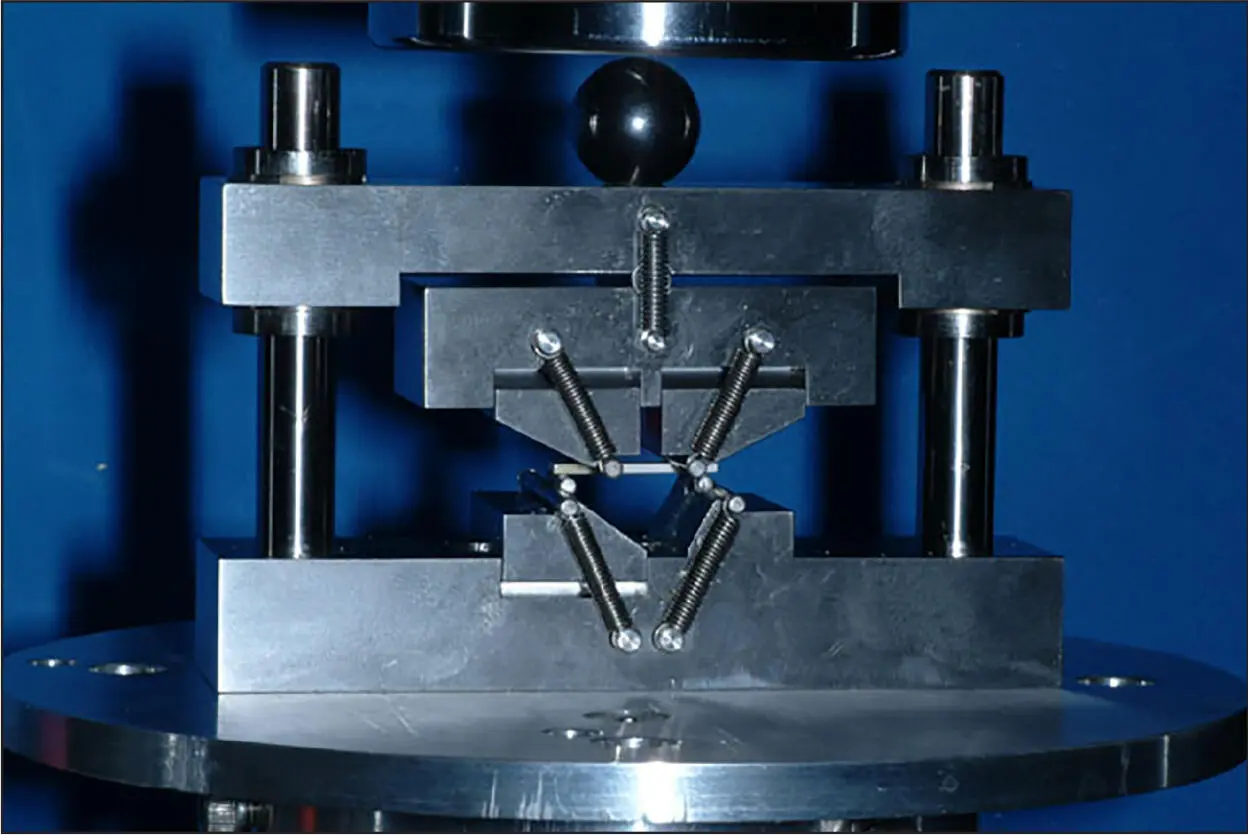
Fig 2-4Bend testing.

Fig 2-5Tensile stress acting on a surface flaw creates quite different responses in metals and ceramics. Crack tips in metals are blunted due to the ductile flow of atoms, which reduces the stress intensity. In ceramics, however, ductile flow is not energetically feasible, and there is no mechanism to reduce stress intensity at the crack tip other than by the creation of two new surfaces—ping!
While strength measures provide valuable screening information, they do not directly predict relative clinical behavior for a number of important reasons. First, the failure mechanism operating clinically will generally be different from that generated in the laboratory. Clinical restorations generally withstand millions of low loads in a wet environment instead of one load in laboratory air. All ceramics are susceptible to the slow growth of cracks under these clinical conditions, and this susceptibility is not measured during simple bend strength testing. Thus, ceramics weaken at different rates during intraoral service. Second, the clinical stress state is more complicated than that during bending. As illustrated in Fig 2-6a, crowns are fully supported by dentin or core materials and often bonded by cement. As will be discussed more fully in chapter 4, failure strengths of such a structure are dependent on the stiffness of the support (elastic modulus), the square of the ceramic thickness, the thickness of the cement, the loaded contact area (ie, the wear facet), and the quality of the cement-ceramic bond. 5None of these variables play any role in laboratory bend testing. Unlike crowns, multiple-unit fixed dental prostheses (FDPs) are complex beams often failing from the gingival portion of their connectors ( Fig 2-6b). Failure strengths function linearly with connector width, with the square of the connector height, in a complex fashion with their radii of curvature (the smaller the radii, the weaker the connector), and with the mobility of the abutment teeth (mobile teeth increase connector stresses). For connectors veneered with weaker porcelain, failures can initiate in this weaker material or from defects at the core-veneer interface. Chapter 3discusses the clinical implications of this potential failure in the case of veneered lithium disilicate FDPs, which are not highly successful, whereas full-thickness (nonveneered) prostheses are. Again, these variables (ie, weakness of connectors) are not evaluated during standardized tensile strength testing. But prostheses are complex, multimaterial structures that do not behave as simple beams do in bending!
Читать дальше
